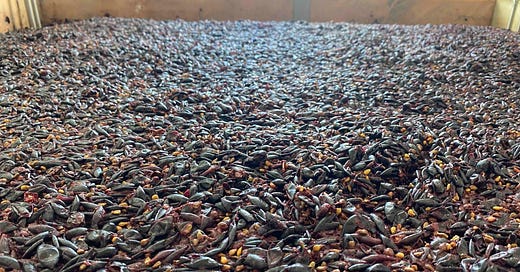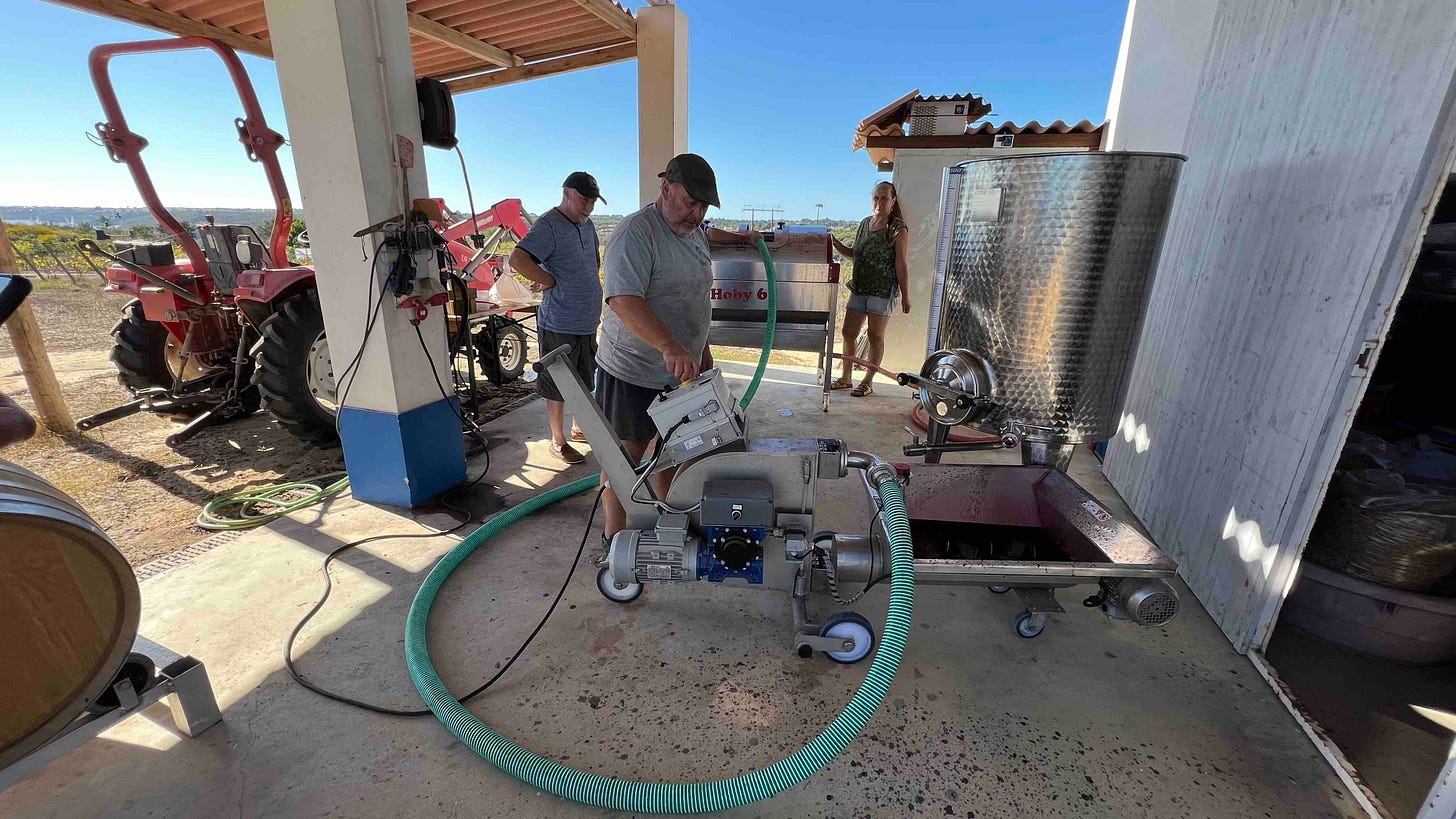It’s grape harvest time in Alentejo and the winelands are littered with tractors and trailers trundling down narrow country lanes bringing newly picked fruit from the fields to the wineries.
And we’ve been lucky enough to get our hands (and our feet) dirty by literally and figuratively immersing ourselves in the wine harvest from some of the biggest to some of the smallest producers in the country.

When we visited the huge Esporão winery in early August, the first of their white wines had just started being collected, crushed and fermented, but those were early days.
Since then the black grapes have been ripening across the region and are being snipped by hand, or gently pulled from their vines by alien-like machines straddling their trellises.
And the threat of a big Atlantic storm heading for Portugal pushed winemakers into some big decisions this week: whether to weather the weather and wait for the rain to pass, or to rush the grapes into the winery before they’re battered and bruised by a downpour.
Many grapes in many places have been harvested already, but there’s still a lot to lose and so our friend Niels decided to go for a final push as the wind picked up and the forecasters predicted a torrential downpour.
Niels and his wife Sibylle have a small vineyard of a handful of hectares overlooking the beautiful estuary of the Mira River and Vila Nova de Milfontes – just half an hour up the Alentejo coast from our house.
They’d already harvested his Portuguese Touriga Nacional and Trincadeira grapes together as they had ripened at the same time, and had been happily fermenting, skins and all, in a stainless steel tank for about ten days.
We rocked up ready to help with the gentle pressing and transferring of all the juice into an oak barrel for it to continue its fermentation without the skins.
First the juice and then the mash of grape skins, pulp and seeds was gently moved to the press with a peristaltic pump which, as Niels explained, uses mechanical contractions in a similar way our intestines push food through our systems.
Compressed air inflating a rubber bag against a metal cylinder carefully extracted all possible juice without crushing the pips which can release a bitter, green tannin if they’re pushed too hard.
Once transferred into a waiting barrel the press needed to be cleaned of the remaining mush...hence the red hands.
Every day is a wine school day for us, as we plan to grow and make our own vinho someday, but we’re not experts yet…so for the experts among you we apologise!
The big lesson from watching the harvest is the difference between the way white and red wines are made.
White grapes are usually pressed into juice and their skins removed straight away before fermentation, but most reds are fermented along with their skins to add colour and flavour.
If you squeeze a black grape of most varieties, it’s white juice that comes out.
That’s why champagnes and sparkling wines can be white even though they are made with a blend including red grapes.
It’s the time spent fermenting with their skins that makes red wine red and adds that bitter tannin which makes it lip-smackingly good.
And most rosé wines are reds that have been allowed to spend just a little time with their skins – sometimes only a few hours – before they’re pressed and sent away for fermentation.
Fact for the day: Alicante Bouschet...a grape rejected by the French and adopted by the Portuguese is one of the few that has red juice and pulp...meaning it’s known as a teinturier.
Our second harvest of the week took us to Herdade do Peso – a vineyard owned by the giant Sogrape group that produces the well-known and well-priced wines known as Trinca Bolotas and Sossego.
They use imagery of the Alentejo landscape in their marketing, and are taking their estate production more up market in their new winery which officially opens in the Spring.
You’ll be hearing more about them in future posts, but we had a fantastic tour with their head of marketing Tiago Oliveira and a chat with winemaker Luís Cabral Almeida.
We watched a big alien machine mechanically, yet brow-risingly gently, remove the grapes in one part of the vineyard while in another a team of women pickers were quickly and deftly snipping bunches into crates with a care reserved for the finer wines.
They often sing while they’re working, but weren’t in the mood when we arrived. Generously they gave us a couple of sample verses before we left...and it was fantastic.
We ended our week stomping grapes in huge pink marble vats at Torre de Palma wine hotel where we have been before and heard all about their harvest tradition.
We met the owners Isabel and Paulo Rebelo who bought the estate when it was in ruins and created what it is today, and tried their fabulous Alicante Bouschet & Tinta Miúda red blend which had just won gold for best red wine at the Portuguese sommelier’s awards. Look out for it!
Assistant winemaker Maria showed us and a couple of guests how to pick a few bunches in the vineyard before joining the barefoot and shorts stomping brigade in the marble lagares.
It’s a strange feeling gradually descending through a thick layer of grape mash before bursting through the surface into the cool juice below and feeling some of the sunken pips underfoot.
It’s not crushing the grapes as such – they are already fermenting in the vats – but it’s a great way of punching down the skins twice a day to keep juice and skins in contact and keep the flavours flowing while fermentation goes on.
Just like with Niels’ press, it’s all about being gentle to stop the pips from being crushed and the wines becoming too bitter. A foot-trodden wine is a smoother wine...or so they say.












Hey Tony - great to hear from you. We're planning to plant a third of a hectare to begin with...on the flat part of our land (much easier!) and then we have more space on the hillside if we ever feel like expanding. The first planting could get us 1500-2000 bottles a year I think...and even at the lower end 4 bottles a day should see us through I hope. It's just for fun...and to understand how it all works!
How many bottles do you hope to produce eventually?